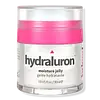What's inside
What's inside
 Key Ingredients
Key Ingredients

 Benefits
Benefits

 Concerns
Concerns

 Ingredients Side-by-side
Ingredients Side-by-side

Water
Skin ConditioningGlycerin
HumectantAlcohol Denat.
AntimicrobialDimethicone
EmollientIsononyl Isononanoate
EmollientAscorbyl Glucoside
AntioxidantBiosaccharide Gum-1
HumectantCaprylyl Glycol
EmollientCarbomer
Emulsion StabilisingChlorphenesin
AntimicrobialCI 14700
Cosmetic ColorantDimethiconol
EmollientMenthoxypropanediol
MaskingNymphaea Alba Flower Extract
Skin ConditioningPanthenol
Skin ConditioningPhenoxyethanol
PreservativePyrus Malus Fruit Water
MaskingSodium Hydroxide
BufferingSodium Palmitoyl Proline
Skin ConditioningTetrasodium EDTA
Tocopheryl Acetate
AntioxidantXanthan Gum
EmulsifyingParfum
MaskingWater, Glycerin, Alcohol Denat., Dimethicone, Isononyl Isononanoate, Ascorbyl Glucoside, Biosaccharide Gum-1, Caprylyl Glycol, Carbomer, Chlorphenesin, CI 14700, Dimethiconol, Menthoxypropanediol, Nymphaea Alba Flower Extract, Panthenol, Phenoxyethanol, Pyrus Malus Fruit Water, Sodium Hydroxide, Sodium Palmitoyl Proline, Tetrasodium EDTA, Tocopheryl Acetate, Xanthan Gum, Parfum
Water
Skin ConditioningGlycerin
HumectantPentylene Glycol
Skin ConditioningGlycereth-26
HumectantCarbomer
Emulsion StabilisingGlyceryl Polyacrylate
Trehalose
HumectantUrea
BufferingStrelitzia Nicolai Seed Aril Extract
Skin ConditioningSodium Hydroxide
BufferingDisodium EDTA
Serine
MaskingBiosaccharide Gum-1
HumectantAlgin
MaskingDisodium Phosphate
BufferingPullulan
Sodium Hyaluronate
HumectantPotassium Phosphate
BufferingCaprylyl Glycol
EmollientPhenoxyethanol
PreservativeWater, Glycerin, Pentylene Glycol, Glycereth-26, Carbomer, Glyceryl Polyacrylate, Trehalose, Urea, Strelitzia Nicolai Seed Aril Extract, Sodium Hydroxide, Disodium EDTA, Serine, Biosaccharide Gum-1, Algin, Disodium Phosphate, Pullulan, Sodium Hyaluronate, Potassium Phosphate, Caprylyl Glycol, Phenoxyethanol
 Reviews
Reviews

Ingredients Explained
These ingredients are found in both products.
Ingredients higher up in an ingredient list are typically present in a larger amount.
Biosaccharide Gum-1 is a sugar created by fermenting sorbitol (which usually comes from potato starch!). It is known for its soothing and moisturizing properties.
Manufacturer tests show this ingredient helped reduce irritation from lactic acid by almost half and kept skin hydrated long-term as a humectant
Beyond hydration, Biosaccharide Gum-1 gives formulas a silky, non-sticky feel.
This ingredient is gentle, versatile, and suitable for all skin types.
Fun fact: Similar sugars can be found naturally in fruits like apples and pears.
Learn more about Biosaccharide Gum-1Caprylyl Glycol is a humectant and emollient, meaning it attracts and preserves moisture.
It is a common ingredient in many products, especially those designed to hydrate skin. The primary benefits are retaining moisture, skin softening, and promoting a healthy skin barrier.
Though Caprylyl Glycol is an alcohol derived from fatty acids, it is not the kind that can dry out skin.
This ingredient is also used as a preservative to extend the life of products. It has slight antimicrobial properties.
Learn more about Caprylyl GlycolCarbomer is a polymer of acrylic acid. Its main role is to create a gel consistency.
A high amount of carbomer can cause pilling or balling up of products. Don't worry, most products contain 1% or less of carbomer.
Glycerin is already naturally found in your skin. It helps moisturize and protect your skin.
A study from 2016 found glycerin to be more effective as a humectant than AHAs and hyaluronic acid.
As a humectant, it helps the skin stay hydrated by pulling moisture to your skin. The low molecular weight of glycerin allows it to pull moisture into the deeper layers of your skin.
Hydrated skin improves your skin barrier; Your skin barrier helps protect against irritants and bacteria.
Glycerin has also been found to have antimicrobial and antiviral properties. Due to these properties, glycerin is often used in wound and burn treatments.
In cosmetics, glycerin is usually derived from plants such as soybean or palm. However, it can also be sourced from animals, such as tallow or animal fat.
This ingredient is organic, colorless, odorless, and non-toxic.
Glycerin is the name for this ingredient in American English. British English uses Glycerol/Glycerine.
Learn more about GlycerinPhenoxyethanol is a preservative that has germicide, antimicrobial, and aromatic properties. Studies show that phenoxyethanol can prevent microbial growth. By itself, it has a scent that is similar to that of a rose.
It's often used in formulations along with Caprylyl Glycol to preserve the shelf life of products.
Sodium Hydroxide is also known as lye or caustic soda. It is used to adjust the pH of products; many ingredients require a specific pH to be effective.
In small amounts, sodium hydroxide is considered safe to use. However, large amounts may cause chemical burns due to its high alkaline.
Your skin has a natural pH and acid mantle. This acid mantle helps prevent harmful bacteria from breaking through. The acid mantle also helps keep your skin hydrated.
"Alkaline" refers to a high pH level. A low pH level would be considered acidic.
Learn more about Sodium HydroxideWater. It's the most common cosmetic ingredient of all. You'll usually see it at the top of ingredient lists, meaning that it makes up the largest part of the product.
So why is it so popular? Water most often acts as a solvent - this means that it helps dissolve other ingredients into the formulation.
You'll also recognize water as that liquid we all need to stay alive. If you see this, drink a glass of water. Stay hydrated!
Learn more about Water